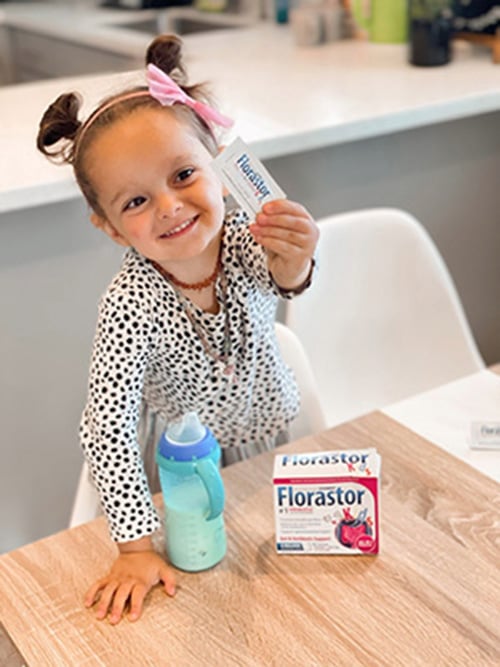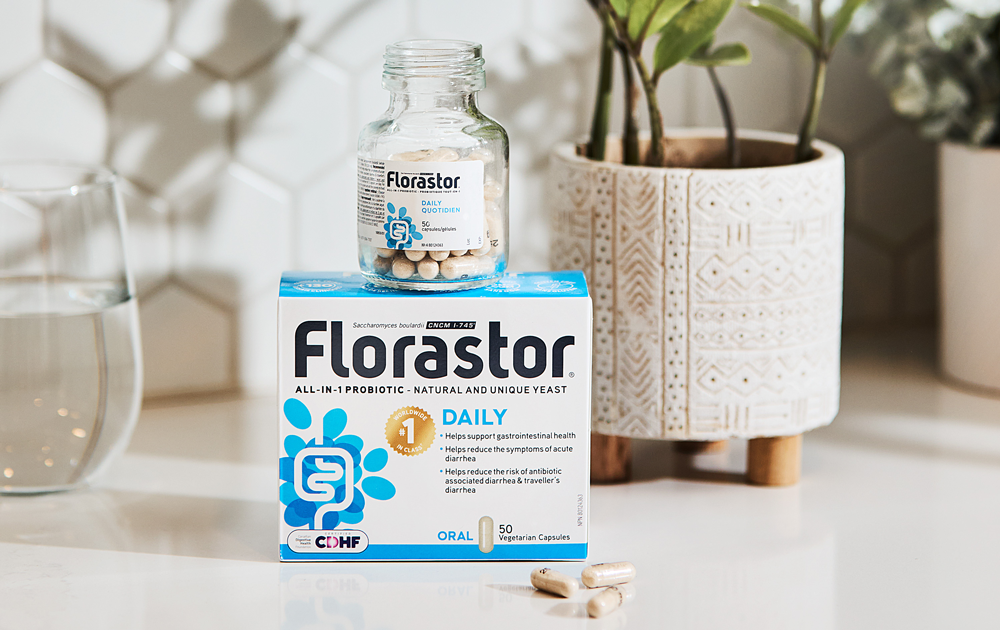Did you know? A child under the age of five has an average of three episodes of diarrhea per year.
Our gut is made up of billions of microorganisms that coexist within the gut in a mutually beneficial partnership: symbiosis.
All of these microorganisms are called Microbiota, they are present in the intestine and in the colon and contribute to the proper digestion of substrates to provide the nutrients and energy we need. They also act as a barrier against external pathogens and have a major role in maintaining and stimulating our immune system.
At birth, the gut microbiota is introduced primarily by the mother, but also by the environment. This newly acquired microbiota varies greatly due to its fragility and immaturity during the first three years of life before gradually becoming relatively stable in adulthood. During this period, factors such as gestational age, mode of birth, preference for breast or bottle feeding, exposure to antibiotics, and short-term illnesses positively or negatively influence the composition of the microbiota developed during these early years.⁴ All of these factors make the gut microbiota of each human unique.
Subsequently, during the course of his or her life, the human being, and even more so the child, is constantly in contact with a multitude of factors influencing the intestinal microbiota, causing or not an imbalance in its composition and/or diversity, this disturbance is also called dysbiosis. For certain factors such as antibiotics, this imbalance can persist long after the treatment. This dysbiosis can have a direct and visual impact on health, reflected in diarrhea, but also a less visible and longer term impact on intestinal health and thus on overall health.
Information highlighted by Dr. Gianluca laniro who explains how dysbiosis is caused by an imbalance in the gut microbiota and how it can have long-term consequences throughout life. He also describes how balance can be maintained and restored, for example by taking Florastor, our probiotic containing our unique Saccharomyces boulardii CNCM I-745® strain.
Florastor Kids® and its unique strain Saccharomyces boulardii CNCM I-745®, a kids-friendly probiotic!

Florastor Kids® has been specially formulated to promote gut health and help support the immune system in your children while pleasing their taste buds. Naturally flavored with Tutti-Frutti, this probiotic is also vegetarian.
Florastor Kids® also helps reduce the risk of antibiotic-induced diarrhea or symptoms during episodes of acute infectious diarrhea by preventing and restoring the imbalance of the intestinal flora.
Florastor® is the only brand of probiotics containing Saccharomyces boulardii CNCM I-745®, a unique probiotic strain that has been studied and used for its effectiveness for over 65 years, making it the probiotic of choice for millions of families worldwide.
FlorastorKids® is suitable for children aged 1 year and older.
May 29 is World Digestive Health Day: Healthy gut bacteria may be linked to lower risk of obesity and diabetes
In the rise of obesity and diabetes in the population, changes in gastrointestinal microbiota have been identified.
Indeed, poor gut health and obesity are also linked. Compared to healthy individuals, the gastrointestinal microbiota of overweight individuals shows patterns of dysbiosis (imbalance of the gut flora). Ultimately, dysbiosis causes greater energy absorption from food, which correlates with inflammation and higher blood sugar levels.⁶ ⁷
This year the World Gastroenterology Organization (WGO) will celebrate World Digestive Health Day on May 29, 2021, with the topic: obesity, an ongoing pandemic. Note that the WGO, an organization recognized worldwide by health professionals, recommends the use of Florastor® probiotics! For more information on this event and on this organization: https://www.wdhd2021.org
- Farthing M, et al. Acute diarrhea in adults and children: a global perspective. Journal of clinical gastroenterology. 2013; 47(1): 12-20.
- Thursby E, Judge N. Introduction to the human gut microbiota. Biochemical Journal. 2017;474(11):1823-1836. doi:10.1042/BCJ20160510.
- Tomas J, Sansonetti P. Host-microbiota dialog: interactions between the microbiota and the intestinal epithelium. In: Marteau P, Dore J, eds. Gut Microbiota: A Full-Fledged Organ. Paris: John Libbey Eurotext; 2017:55-64.
- Butel M, Lepage P, Collignon A. Microbiota development: from the in utero period to the first few years of life. In: Marteau P, Dore J, eds. Gut Microbiota: A Full-Fledged Organ. Paris: John Libbey Eurotext; 2017:25-34.
- Petersen C, Round JL. Defining dysbiosis and its influence on host immunity and disease. Cellular Microbiology. 2014;16(7):1024-1033. doi:10.1111/cmi.12308
- Miller SA et al. The association between antibiotic use in infancy and childhood overweight or obesity: a systematic review and metaanalysis. Obes Rev. 2018 Nov;19(11):1463-1475.
- Tilg H et al. The intestinal microbiota fuelling metabolic inflammation. Nat Rev Immunol. 2020 Jan;20(1):40-54


.jpeg?sw=375&sfrm=png&q=90)


